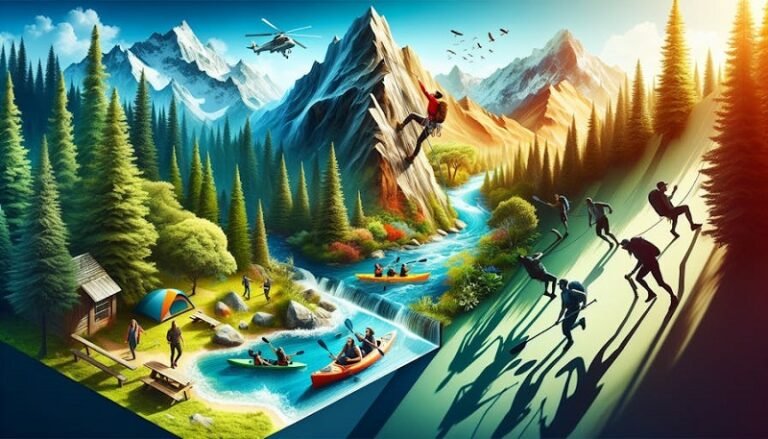Solo Hiking Trips: The Thrills and Challenges of Hiking Alone

Solo Hiking Trips
Taking a solo hike is an awesome way for outdoor fans to really soak up nature and push their limits a bit. But to have a great time and stay safe, you gotta keep a few key things in mind about planning and gear.
Planning Essentials
Hitting the trail by yourself means you get to decide everything—where to go, how fast to walk, when to rest. But this freedom also means you’ve got to be extra smart about planning. Here’s what to think about before you lace up your boots:
- Route Research: Know the trail like the back of your hand—distance, how tough it is, where the hills are, spots to grab water, and any possible hazards. This way, you’ll make smart choices once you’re hiking.
- Emergency Plan: Have a backup plan ready. Let someone know your route, when you expect to be back, and what to do if something goes wrong. Don’t forget safety gear like a whistle, first aid kit, and a charged mobile phone.
- Weather Check: Keep an eye on the weather for your hiking spot and be ready in case it changes. Dress in layers and pack gear for rain or cold just in case.
Gear Considerations
Picking the right gear can make or break your hiking trip. Pay attention to these gear essentials to keep things comfy, safe, and fun:
| Gear Item | Description |
|---|---|
| Footwear, Socks, Knee Poles | Grab some sturdy boots with ankle support and good grip. Fresh socks and knee poles add extra comfort and help prevent injuries. |
| Backpack | A 36-liter backpack with features like easy front access, a rain cover, outside pockets, and comfy straps is a good choice for keeping your gear organized. |
| Navigation Tools | Backup your GPS with paper maps so you’re not in trouble if your device runs out of battery or loses signal. |
| Food and Water | Take plenty of food and water to stay hydrated and keep your energy up. |
| Clothing and Safety Equipment | Wear the right clothes for the weather and pack basics like a first aid kit, emergency blanket, flashlight, and a multi-tool for safety. |
Keep these tips in mind and gear in check for a solo hike that’s safe and fun. With the right prep, you’ll be all set for a fantastic adventure out in the wild!
Solo Hiking Destinations
Setting out on solo hiking endeavors means picking the right place, so your adventure is safe and as fun as falling into a giant marshmallow. Just like Goldilocks, you want to find a hike that’s just right for you. Matching your hiking journey with your fitness mojo and trail intensity matters.
Fitness-Matched Hikes
Different solo hiking spots cater to just about any level of fitness and outdoor know-how. It’s like matchmaking but with nature. Take a second to consider how strong and peppy you’re feeling before choosing where your feet will land. A trail that vibes with your energy level makes the experience more enjoyable and less likely to leave you in a heap of regret (and possibly Band-Aids).
Do a little homework on your trail of choice. Check out how far it is, how steep it could get, and whether you’ll be dodging rocks or just skipping down a path. It should challenge just enough, making you feel like an explorer without needing rescue. If you’re just getting started, picking well-marked routes that ease you in can be the perfect jump-off point to get your hiking groove on.
Difficulty Levels
There’s a bit of everything when it comes to trail difficulty levels – some paths are as easy as pie, and others make your leg muscles scream for mercy. What makes a trail tough? Think of wicked steep climbs, dizzying elevation changes, trails that look more like goat paths, and endless stretching distances. Knowing what level of punishment… I mean difficulty, you’re signing up for can make your hike a breeze or a beast.
Take stock of your hiking history, how fit you are, and if you’ve got Bear Grylls-like skills (or not). Newbies might find happiness on easy treks, where paths are as clear as day and there’s nothing too gnarly to contend with. But if you’ve hiked so much you’ve got your own playlist in your head for every step, you might be itching for something extreme and testing (Hiking For Her). Knowing the challenge level helps set your pace, so you’re not keeling over halfway through.
Picking solo hiking hot spots that match your fitness and trail toughness makes the experience something worth framing on your brain’s wall of fame. Dive into info gathering and plotting so you end each hike grinning like a fool amid nature’s glory. Need more advice on staying safe and gearing up? Take a peek at our articles on hiking safety stuff and must-have hiking gear.
Safety Measures
When hitting the trails alone, your safety is numero uno. Especially when you’re exploring the great outdoors, far from civilization. Let’s talk about how to keep your solo hiking adventures safe and sound with smart planning and good ol’ common sense.
Guidelines and Rules
If you’re setting out solo, sticking to some tried-and-true safety rules is your best bet for a smooth hike. Think of these as your personal trail insurance—keeping you prepared and ready to tackle whatever nature throws your way. Here’s how to gear up for a safe trek:
- Map out your trail before you hit it.
- Gear up with navigation tools, a first aid kit, and maybe an emergency beacon.
- Peek at the weather report—don’t want any surprises!
- Give a pal a heads-up about your plans and route.
- Sport the right clothes and sturdy boots – nobody likes soggy socks!
- Keep yourself fueled and hydrated with enough snacks and H2O.
For more tips and tricks on solo hiking, check out Solo Traveler and become a safety-savvy hiker.
Navigation Precautions
When it comes to finding your way solo in the wilderness, being a top-notch navigator goes a long way. You’ll feel like a champ when you use a mix of trusty paper maps and high-tech GPS.
While that GPS gadget is nifty, always carry a paper backup. This way, you won’t be stuck if your device throws a tantrum or loses signal. Having both means you’ll tackle even the toughest trails without a hitch and avoid those head-scratching moments where you’re wondering if you’ve been here before.
For some seriously handy navigation hacks, check out Hiking For Her. It’s a treasure trove of tips to keep you on track, even when blazing new trails.
Off-Trail Hiking Challenges
Off-trail hiking is like venturing into the great unknown, striving to find paths where there are none. This kind of adventure brings its own set of tests, way different from those you’d find on your neighborhood trail. To ensure a seamless and exhilarating journey, it is essential to prepare for the challenging landscape and unforeseen obstacles. Here’s a sneak peek into two of the biggest tests you’ll face out there – dealing with uneven land and prepping for obstacles.
Terrain Surprises
Imagine wandering through areas that surprise you at every corner – uncharted grounds where you could encounter anything from thick woods to bumpy rocks. Hiking on these unpredictable surfaces requires quick thinking because the nice, flat ground isn’t always what you’ll get. The maps you have might be a bit like that old pirate map – they might not show everything exactly as it is. This, my friend, is where your mental grit comes in handy.
Shuffling through changing terrains means being a hawk-eyed observer and ready to shift gears. Be alert with the landmark spotting! It’ll help keep you on top of where you are, even when the scenery gets tricky. And yes, split-second decision-making is your buddy here, to ensure you don’t end up in some deserted spot.
Handling Hurdles
When trails aren’t marked out for you, there are bound to be some hurdles you can’t just hop over or sidestep. From climb-worthy rocky ledges to those annoying fallen logs and dense green mazes that might appear before you – handling these needs a plan. The right tools and know-how are the keys to getting past these blockades without turning back or, well, panicking.
When you’re facing these hurdles, don’t let panic win. Mastery means keeping a chill vibe, taking it in stride, and maybe opting for a detour when things look dicey. A little foresight goes a long way. Think of alternative paths before setting foot on that wild adventure, carry solid navigation stuff, emergency supplies, and of course, stay safe all around.
Getting prepped for the quirky terrains and mystery obstacles of off-trail hikes amps up the thrill of outdoors life. It lets you channel your explorer spirit with a dash of confidence. While enjoying the trails less traveled, don’t forget to be a kind guest to Mother Nature – keep it clean, leave no traces behind, and soak up the planet’s raw, untouched beauty.
Mental Preparedness
Let’s chat about adventures on the trail, flying solo. Ready to hit that emerald maze? Mental preparation is your secret weapon for this type of adventure. Two biggies to think about: having the right attitude and gearing up your skills.
Attitude and Adaptability
Get your game face on, ’cause attitude’s everything out there. The wilderness can toss a few curveballs your way. Keep your chin up, and it turns a sketchy moment into a story to tell ’round the campfire. Rocking a positive vibe helps you own whatever comes your way—like that time it rained cats and dogs, and you had to hop over puddles to stay dry (Hiking For Her).
Flexibility is king. You gotta bend like a willow when those clouds roll in or when there’s a fallen tree blocking your path. Being able to switch gears and stay cool is how you win at solo hiking. Look at any hiccup as a way to learn and grow. Who knows? It might turn into your favorite memory.
Skill Development
Wanna be the superhero of the backwoods? Learn some slick skills. Navigation, first aid, and basic survival tricks are a must-have in your toolkit. These fellas come in handy when you find yourself in a pickle, far from home base.
Got your nose for trouble? Picking up on changes in the landscape is part of the game. Being able to spot and dodge potential dangers boosts your decision-making mojo. Wrap your head around the safety know-how and get comfy being your own best company while you’re on the trail.
Solo hiking is a wild ride with epic views and soul-soothing quiet. But it ain’t for the faint-hearted—you need nerve, a sense of humor when things go sideways, and some extra tricks up your sleeve. By keeping your spirits high, rolling with the punches, and brushing up on your camping-cool skills, you’ll own that trail and bask in the undisturbed beauty around you. Want more hiking nuggets of wisdom? Dive into our article on hiking safety tips for all the scoop.
Day Hiking Essentials
When you hit the trails, it’s good to have the right stuff at your fingertips. Whether you’re doing a quick walk or a lengthy adventure, being prepared means everything.
Short Adventure Packing
If you’re out for 2 hours or less, pack smart so you’re not lugging too much. Here’s the stuff you gotta pack:
| Essentials |
|---|
| Lightweight backpack |
| The right clothes |
| Good shoes |
| Snacks |
| H2O |
| Map or compass |
| First aid kit |
Peek at the weather plan before you head out, and if it might rain or get chilly, pack some gear for that. Be ready for surprises (REI).
Longer Trek Preparation
For hikes stretching over 2 hours, especially those deep in nature, you’ll need a bit more to keep you going. Pack these for longer trips:
- Extra Stuff:
- More layers for warmth as needed.
- Energy food like bars and nuts.
- Tools to find your way back.
- Medical supplies if things go south.
- Snack Staples:
- Bring munchies like bars, jerky, and nuts for easy eating.
- A sandwich isn’t a bad idea if it’s around mealtime.
- Make sure you have enough chow to stay pumped up on the trail.
With the right goodies in your bag, you can make your hike great and be ready for anything that pops up. For more goodies on staying safe and what to bring, peep at our articles on hiking safety and gear to carry.
Hiking Solo vs. Group
Choosing how to go hiking ain’t just about whether you take the path less traveled by yourself or join the crowd. It’s about what kind of adventure you’re after and how you want to experience Mother Nature’s grand show.
Benefits and Challenges
Hiking alone is like having a chat with yourself while getting cozy with nature. You set your own pace, make your own path, and get lost in that sweet, sweet solitude (source: Nomadic Matt). It’s like a little escape where you get to be king or queen of the trail without worrying about anyone else’s plans. But, hey, solo hiking’s not all sunshine and rainbows. You’re out there on your own, responsible for lugging your gear and keeping yourself out of trouble. One misstep and without a buddy to call for help, you’re in a bit of a pickle. So yeah, make sure someone knows where you’re wandering off to and pack your essentials. Here’s a lifeline – hiking safety equipment.
Now, if you’re more of a people person, hiking in a group fits like a glove. Imagine trekking with folks who share your love for packing peanut butter sandwiches and stopping to snap selfies. There’s safety in numbers and you stand a better chance with company if something goes south (Safe-LifeAlerting Devices Australia P/L). Plus, dividing chores makes life simpler—someone’s the compass while you carry the snacks.
But, trail-blazing together ain’t all smooth sailing. Herding cats, er, organizing people means settling for times and places that aren’t just what you’d choose. Not everyone hikes at the same speed, and debates over whether to detour to see a waterfall can be a bore.
Personal Considerations
Should you hike alone or with others? Well, it’s your scene. Love the idea of soul-searching in the woods and relying on your wits? Going solo could be your jam. Start small—enjoy easy trails first, work up to the big leagues as you get braver (source: Nomadic Matt).
If making memories with buddies, sharing stories, and the buddy system is more your kind of gig, then rally some troops and go group hiking. Joining a club or signing up for guided hikes gives you that ready-made social vibe.
In the end, whether you march to the beat of your own drum or dance along with a group, keep safety front and center. Plan it right, prep like a pro, and you’ll walk away with tales to tell from your adventure.
Risk Avoidance
When jumping onto a solo hike, keeping safety in mind is the name of the game. In this section, you’ll find handy tips and upfront strategies that every solo hiker ought to keep under their hat.
Precautionary Measures
Alright, folks, whether you’re trekking across the state park or tackling rugged backcountry trails, safety’s gotta be your buddy on solo hikes. Before you lace up those boots, take these precautionary steps to dodge any monkey business:
- Planning Your Route: Do your homework before venturing out. Know your route like the back of your hand—trail conditions, any sketchy spots. Having a plan helps you stay on track and dodge surprises.
- Packing Proper Gear: You wouldn’t bake a cake without the right ingredients, right? Pack navigation tools, a first aid kit, and an SOS beacon. They’re like your sidekicks for emergencies. Hop over to our hiking gear essentials for some extra tips.
- Checking Weather Forecasts: Don’t leave your safety up to a flip of the coin with the weather, keep your eye on the sky. Change is nature’s specialty, so gear up for whatever it’s got planned.
- Informing Someone of Your Plans: Tell a pal or family member your game plan—route, return time, who to call if things go south. This way, someone’s got your back if plans go off the rails.
- Wearing Appropriate Clothing and Footwear: Dress smart. Your feet will thank you for steady boots, and you’ll appreciate the jacket when the sun dips.
- Bringing Ample Food and Water: Keep the tank full! Stash enough grub and water for the journey so your energy doesn’t flatline midway through.
Stick to these guidelines, and you’re setting yourself up for smoother hiking days, minimizing hiccups during your solo escapades.
Smart Preparation
To dodge drama and soak up the journey, a little smart prep goes a long way. Get ahead of the curve with these strategies to tackle anything that pops up:
- Training and Fitness Preparation: Let’s face it, the trail’s no place to learn you’re not in shape. Put in some training—get those legs ready and boost your endurance. It’ll make hiking feel like a walk in the park.
- Maintaining a Positive Mindset: A hike’s a mental game, too. Keep your chin up, stay flexible, and focus on the prize. Smiling at the challenges makes ’em easier to conquer.
- Knowing Personal Limits: Be honest about what you can handle. Your body will give you hints—listen! Pushing too hard can lead you astray, so be ready to shift gears if need be.
Getting these smart prep habits down pat lets you take the reins of your adventure, keep safe, and unlock the sheer fun of exploring solo!






